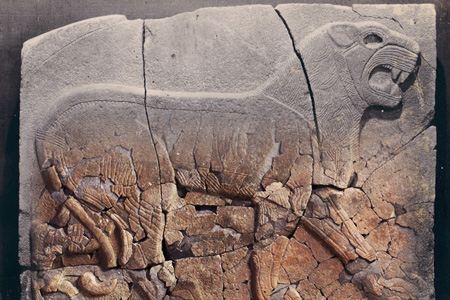 After nine years of shifting through WWII bombing debris, restoration experts have puzzled back together over 30 Aramaean sculptures and reliefs. Watch the slideshow.
After nine years of shifting through WWII bombing debris, restoration experts have puzzled back together over 30 Aramaean sculptures and reliefs. Watch the slideshow.
When in November 1943 an air raid on Berlin destroyed the Tell Halaf Museum and its contents, it was thought one of Germany’s most important Near Eastern collections was lost forever. A year later more than 27,000 fragments were recovered from the museum’s ruins and taken to the cellars of the Pergamon Museum for storage. Luckily, archaeologists never throw something away. Restoration of the 3000-year-old sculptures and bas-reliefs eventually started in 2001. Now, after almost a decade, the team is near finished and over 30 Aramaean artefacts are ready to go on display again.
The Ancient City of Tell Halaf
Tell Halaf, in the Syrian desert, was discovered by Max von Oppenheim in 1899, but he did not start excavating until 1911. From 1911 to 1913 and after the First World War, from 1927 to 1929, the mission unearthed a citadel containing two palaces, an inner and outer city wall, gate complexes, several tombs and the so-called ‘cult-room’.
The ancient settlement is dated to the second millennium BC, when after the fall of the Hittite empire, Aramaean tribes crossed the Euphrates and moved into northern Syria, founding small independent Kingdoms.Tell Halaf became the city-stateof Guzana, or Gozan.
Inscriptions found by Oppenheim at Tell Halaf say the Western Palace was constructed by Aramaean ruler Kapara, of the house of Bachiani, probably around the 9th century BC.
Yet, the site was inhabited even earlier. Oppenheim’s team discovered painted pottery, now dated to the sixth and fifth millennium BC.
New excavations at the archaeological site started in 2006.
The Tell Halaf Museum
Oppenheim brought many of the artefacts to Berlin. Yet, the Berlin Royal Museums could not afford purchasing them and the Aramaean treasures were not housed in the Pergamon Museum as originally planned. Instead, they got their own dedicated museum, a converted machine shop in Berlin-Charlotteburg.
The Tell Halaf Museum opened in 1930 and its monumental reconstruction of the Western Palace’s faade was the focus of national and international attention at the time.
World War IIDestruction
In 1943, the museum was hit by a World War IIphosphor bomb, triggering a huge fire. The blaze destroyed all wooden and limestone artefacts, as well as the plaster casts.
The basalt rock statues and bas-reliefs withstood the scorching heat, but not the temperature shock caused by the cold water used in an attempt to extinguish the fire. The surviving Aramaean artefacts shattered in thousand pieces.
Oppenheim did not give up, and envisioned a rescue attempt. It would of course be truly wonderful if the smashed fragments of the stone images could somehow be gathered together and brought to the Staatlichen Museen and reassembled at a later date, Oppenheim requested in 1944.
So it happened. Nine truckloads of debris were gathered and taken to the Pergamon Museum for storage.
Restoring and Reassembling
Only after the fall of the Berlin Wall and German reunification, the Cologne-based Oppenheim Foundation got access to the Tell Halaf fragments, kept in wire baskets on pallets in the museum’s basement. A first survey in 1933 raised the hopes that restoration of at least a few pieces such asthe two large lions from the entrance to the West Palace, the head of a sphinx and the torso of a big bird would be possible. Negotiations between the Max Baron von Oppenheim Foundation, owner of the valuable debris, and the Foundation of Prussian Cultural Heritage commenced.
In 2001, the basalt fragments were brought to their sorting hall, and the tedious reassembly and restoration work started. About 27,000 fragments were spread out on more than 200 wooden palettes, and the pieces that could be identified separated.
Almost ten years later, archaeologists and restorers have reassembled more than 90% of the archaeological collection, with only about 2,000 unidentified fragments left.
After 68 Years, On Display Again
Starting next year, 68 years after their destruction, the restored treasures will again be shown to the public, in an exhibition that willrival the dislay of the Armanaean collection at the Aleppo Museum. A specially designed lighting concept will help present the monumental sculptures and relief panels in their original glory – without covering up their scars and wounds. Accompanying theartefacts will be information on the restoration process, as well as original film footageand photographs from Max von Oppenheim’s excavations.Alongside the now completed restoration project, the excavations that recommenced at Tell Halaf in 2006 will also be presented to the public in the exhibition.
From January 28 to August 14 2011, the artefacts will be shown in the North Wing of thethe Pergamon Museum, in ‘Die geretteten Gtter aus dem Palast vom Tell Halaf‘,after whichthe artefacts will be integrated into the new entrance to the museum’s Near East department.